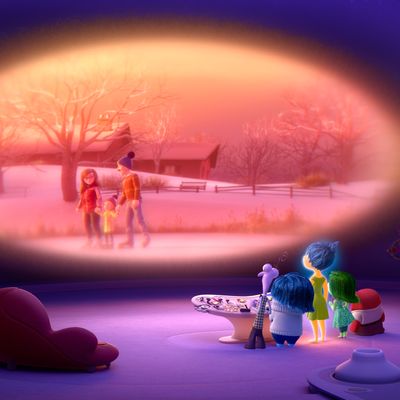
Ever since Pixar began showing previews of Inside Out, critics have been raving about its stunning animation, beautiful soundtrack, and creative portrayal of protagonist Riley’s inner world. Daphna Shohamy, a researcher at Columbia University’s Zuckerman Mind Brain Behavior Institute, appreciates Pixar’s latest movie for a different reason: She believes it has potential as an educational tool.
“I’m excited that people will learn from this movie about how malleable memories are,” she said. Shohamy was part of a group of scientists the filmmakers consulted during the making of the movie, and she explained a few things Inside Out can teach us about memory and the brain.
Memories are susceptible to change.
In the movie, if Sadness touches one of Riley’s happy recollections, it can become tainted by sadness. That’s a scary proposition, and one that isn’t far from the truth. “They took a concept that is absolutely true in terms of how memories work,” Dr. Shohamy said. “When we retrieve a memory, we bring it back to life, and that will change the way it’s re-stored. It’s a complicated thing to grasp — it’s not like you take a file out and put it back exactly the way it was. They took that idea and used it in a way I thought was beautiful and accurate and incredibly helpful, from an educational standpoint. They made it seem so intuitive — when you bring a memory back from storage and something from the present touches it, that can change the memory.”
Researchers have demonstrated the malleability of memory in different contexts. Elizabeth Phelps, a psychologist at New York University, has conducted experiments on how memories can be manipulated. (Her research could have implications for the treatment of PTSD.) In one 2009 experiment, Phelps showed people colored squares just before administering an electric shock to their wrists; afterwards, seeing the colored square made them sweat and feel fearful. But if the researchers brought them back to the lab and showed them the color without giving them a painful shock, the fear response could be eliminated in both the short term (the next day) and the long term (a year later).
False memories can also be implanted: In one study from 2001, psychologist Elizabeth Loftus had people who’d visited Disneyland read ads for the theme park that featured Bugs Bunny; one-third then claimed to remember meeting Bugs Bunny (a Warner Bros. character) on their trip to Disneyland. In another recent experiment, Lawrence Patihis, a researcher at the University of California, Irvine, asked people with “highly superior autobiographical memory” — people who could remember details like the date on which an Iraqi journalist threw a shoe at George W. Bush — to recall video footage of United Airlines Flight 93 crashing in Pennsylvania on 9/11. Twenty percent of his subjects began reminiscing about watching this footage, which does not exist.
Some memories are disproportionately important to our sense of self.
With the concept of “core memories,” the writers have “really captured something essential, which is that not all memories are created equal,” said Dr. Shohamy. “Not all experiences lead to the creation of long-lasting, robust memories.” Experiences are more likely to turn into long-term memories if they’re emotional or otherwise important.
The representation of memories as individual balls might be misleading.
“A lot of the research treats memories as discrete events, mini-stories: when something started, when it ended. The ball captured that definition of memory, but newer theories focus on how those kinds of different memories influence each other and how we integrate them.” A child learning about a dog, for example, “might have a separate memory of each dog” he’s seen, “but can integrate these memories and extract information so those memories influence each other and come together.”
Memories are constantly exerting influence on our behavior in the present.
Riley’s memories are fundamental to her identity; when they get “lost” in her brain, her personality begins to change. As Dr. Shohamy explained, “Memories in the movie were very obviously not just something to reminisce about. They were very alive, very influential in the protagonist’s behavior. People often don’t understand how important memory is all the time: It’s not just a record of the past. The movie shows, moment by moment, how memories create the structure of who we are.”




